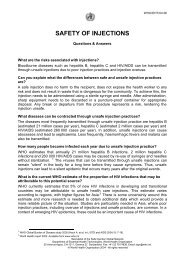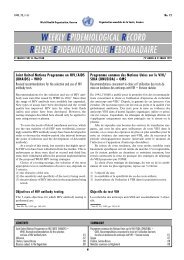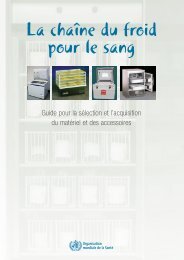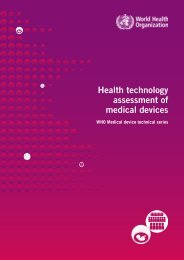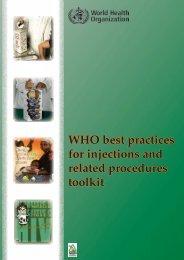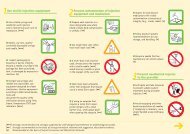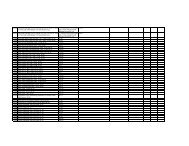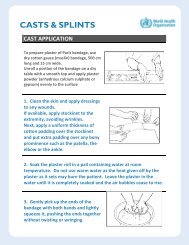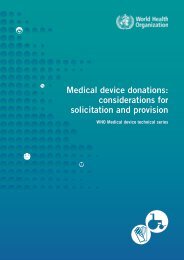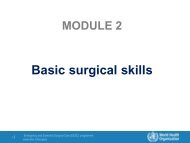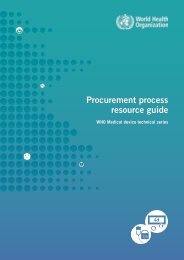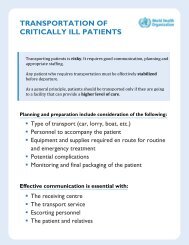WHO Guidelines on Drawing Blood: Best Practices in Phlebotomy
WHO Guidelines on Drawing Blood: Best Practices in Phlebotomy
WHO Guidelines on Drawing Blood: Best Practices in Phlebotomy
- No tags were found...
Create successful ePaper yourself
Turn your PDF publications into a flip-book with our unique Google optimized e-Paper software.
6 Paediatric and ne<strong>on</strong>atal blood sampl<strong>in</strong>g.....................................................................................35<br />
6.1 Background <strong>in</strong>formati<strong>on</strong> <strong>on</strong> paediatric and ne<strong>on</strong>atal blood sampl<strong>in</strong>g....................................... 35<br />
6.1.1 Choice of procedure and site ......................................................................................... 35<br />
6.2 Practical guidance <strong>on</strong> paediatric and ne<strong>on</strong>atal blood sampl<strong>in</strong>g................................................. 35<br />
6.2.1 Patient identificati<strong>on</strong> ..................................................................................................... 35<br />
6.2.2 Venepuncture................................................................................................................. 36<br />
6.2.3 F<strong>in</strong>ger and heel-prick ..................................................................................................... 37<br />
6.3 Illustrati<strong>on</strong>s for paediatric and ne<strong>on</strong>atal blood sampl<strong>in</strong>g........................................................... 37<br />
7 Capillary sampl<strong>in</strong>g......................................................................................................................41<br />
7.1 Background <strong>in</strong>formati<strong>on</strong> <strong>on</strong> capillary sampl<strong>in</strong>g.......................................................................... 41<br />
7.1.1 Choice of site ................................................................................................................. 41<br />
7.1.2 Select<strong>in</strong>g the length of lancet......................................................................................... 42<br />
7.1.3 Order of draw................................................................................................................. 42<br />
7.1.4 Complicati<strong>on</strong>s................................................................................................................. 42<br />
7.2 Practical guidance <strong>on</strong> capillary sampl<strong>in</strong>g.................................................................................... 43<br />
7.2.1 Selecti<strong>on</strong> of site and lancet............................................................................................. 43<br />
7.2.2 Procedure for capillary sampl<strong>in</strong>g.................................................................................... 43<br />
7.3 Illustrati<strong>on</strong>s for capillary sampl<strong>in</strong>g............................................................................................. 45<br />
PART III IMPLEMENTATION, EVALUATION AND MONITORING..........................................................47<br />
8 Implement<strong>in</strong>g best phlebotomy practices...................................................................................49<br />
8.1 Sett<strong>in</strong>g policies and standard operat<strong>in</strong>g procedures.................................................................. 49<br />
8.2 Procurement.............................................................................................................................. 49<br />
8.2.1 <strong>Blood</strong>-sampl<strong>in</strong>g equipment............................................................................................ 50<br />
8.2.2 Protecti<strong>on</strong>....................................................................................................................... 50<br />
8.3 <strong>Phlebotomy</strong> tra<strong>in</strong><strong>in</strong>g................................................................................................................... 51<br />
8.4 Safe waste and sharps disposal.................................................................................................. 51<br />
8.5 Preventi<strong>on</strong> and management of <strong>in</strong>cidents and adverse events................................................. 52<br />
8.5.1 Patient related................................................................................................................ 52<br />
8.5.2 Health-worker related.................................................................................................... 53<br />
8.5.3 Risk assessment and risk reducti<strong>on</strong> strategies................................................................ 54<br />
9 M<strong>on</strong>itor<strong>in</strong>g and evaluati<strong>on</strong>.........................................................................................................55<br />
PART IV REFERENCES......................................................................................................................57<br />
PART V ANNEXES............................................................................................................................63<br />
Annex A: Methods and evidence base...........................................................................................65<br />
Annex B: Infecti<strong>on</strong> preventi<strong>on</strong> and c<strong>on</strong>trol, safety equipment and best practice............................69<br />
Annex C:<br />
Devices available for draw<strong>in</strong>g blood................................................................................71<br />
Annex D: Manag<strong>in</strong>g occupati<strong>on</strong>al exposure to hepatitis B, hepatitis C and HIV...............................73<br />
Annex E: Tra<strong>in</strong><strong>in</strong>g course c<strong>on</strong>tent for phlebotomists .....................................................................77<br />
Annex F:<br />
Expla<strong>in</strong><strong>in</strong>g the procedure to a patient.............................................................................79<br />
Annex G: Disassembly of needle from syr<strong>in</strong>ge or other devices......................................................81<br />
Annex H: <strong>Blood</strong> spillage ................................................................................................................83<br />
Annex I:<br />
Annex J:<br />
Modified Allen test.........................................................................................................85<br />
Cochrane review.............................................................................................................87<br />
Annex references...........................................................................................................................103<br />
Glossary ........................................................................................................................................105<br />
iv<br />
<str<strong>on</strong>g>WHO</str<strong>on</strong>g> guidel<strong>in</strong>es <strong>on</strong> draw<strong>in</strong>g blood: best practices <strong>in</strong> phlebotomy



